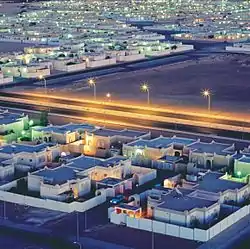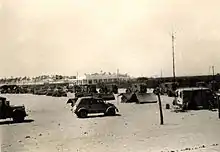Hun, Libya
Hun or Houn /ˈhuːn/ (Arabic: هون Hūn) is an oasis town in the northern Fezzan region of southwest Libya. The town is the capital of the Jufra District. The "International Autumn Tourism Festival", is an annual festival usually held at the end of September.
Houn
هون | |
|---|---|
Town | |
 A view from modern Hun, Libya | |
 Houn Location in Libya | |
| Coordinates: 29°07′16″N 15°56′25″E | |
| Country | |
| Region | Fezzan |
| District | Jufra |
| Elevation | 850 ft (259 m) |
| Population (2010)[1] | |
| • Total | 30,715 |
| Time zone | UTC+2 (EET) |
History

During the colonial Italian Libya period, Hun was the administrative capital of the Italian Fezzan region, called Territorio del Sahara Libico. Hun was the Italian military center of southern Italian Libya, and was not part of the national Fourth Shore territory of the Kingdom of Italy as Italian Tripolitania and Italian Cyrenaica. In the 1939 census Italians were 3% of the total population of 35,316 in the city. They disappeared from Hun after Italy's loss of Libya in World War II. An important Libyan Italian born in Hun was the internationally renowned painter Mario Schifano (1934–1998). In the 1930s the Italian government made some important improvements to the small town, including a connection to the coast via the new Fezzan Road.[2]
During the Libyan Civil War, on 8 May 2011, NATO hit 8 headquarters compound buildings, 12 ammunition storage and 20 vehicle storage.[3]
Geography
Hun is about halfway between Sabha and the Mediterranean coast in the Sahara Desert. The natural landscape around Hun mainly consists of black basalt mountains, with extensive sand dunes, and date palm trees - Phoenix dactylifera groves indicating oases. The cities of Waddan and Sokna are the nearest settlements. There is a ruined ksar and several mosques in the city of Waddan. All three towns are oases characterized by the abundance of natural springs and date palm trees.[4] Hun has a hot desert climate (Köppen climate classification BWh) with long, extremely hot summers and short, warm winters as well as very little rainfall throughout the year. In this part of the desert, summer daytime temperatures are a bit moderated due to the influence of the cooler offshore winds from the Mediterranean Sea, although averages high temperatures consistently exceed 40 °C (104 °F) during the hottest months of the year.[5] The region receives an average annual rainfall of 2.5 in (64 mm).[6]
Economy and culture
There are public buses to the cities of Sirte and Sabha. There is also a military airport located between Hun and Waddan, Al Jufra Airbase. Hun is 240 km south of Sirte, 370 km from Misrata and 272 km north of Sabha.[7] The "International Autumn Tourism Festival", is an annual festival usually held at the end of September. It is organized for four days every year from 1996. It is aimed at promoting tourism and culture and organizes concerts and exhibitions.[8]
See also
Notes
- estimated "Libya: largest cities and towns and statistics of their population". Archived from the original on 2012-12-08. World Gazetteer
- Kelly, Christopher; Laycock, Stuart (2015). Italy Invades. Greenleaf Book Group. p. 63. ISBN 9780996882507.
- "Nato positions" (PDF). NATO. Retrieved 28 November 2016.
- McColl, R. W. (2014). Encyclopedia of World Geography, Volume 1. Infobase Publishing. p. 543. ISBN 9780816072293.
- Otman, Waniss; Karlberg, Erling (2007). The Libyan Economy: Economic Diversification and International Repositioning. Springer Science & Business Media. pp. 1–3. ISBN 9783540464631.
- "Libya profile". 2016. Retrieved 23 November 2016.
- "Distance from Tripoli". Wolframa. Retrieved 22 November 2016.
- "Khoms summer festival starts; Hun festival planned for October". Libya Herald. Retrieved 12 November 2016.
Hun is Capital of Aljufra region. It has the high population. It has the local government building, which including Mayor office, financial and development offices.